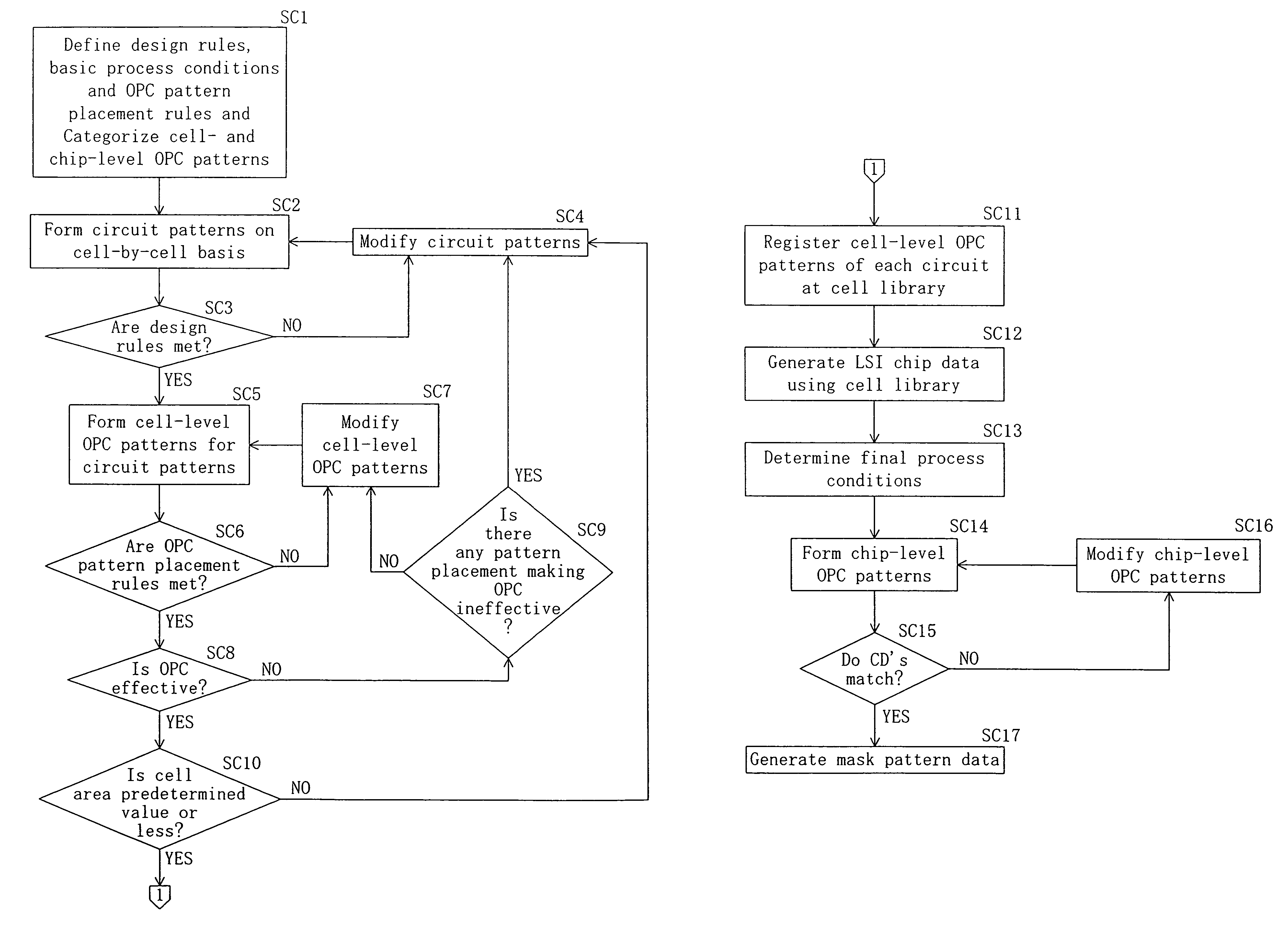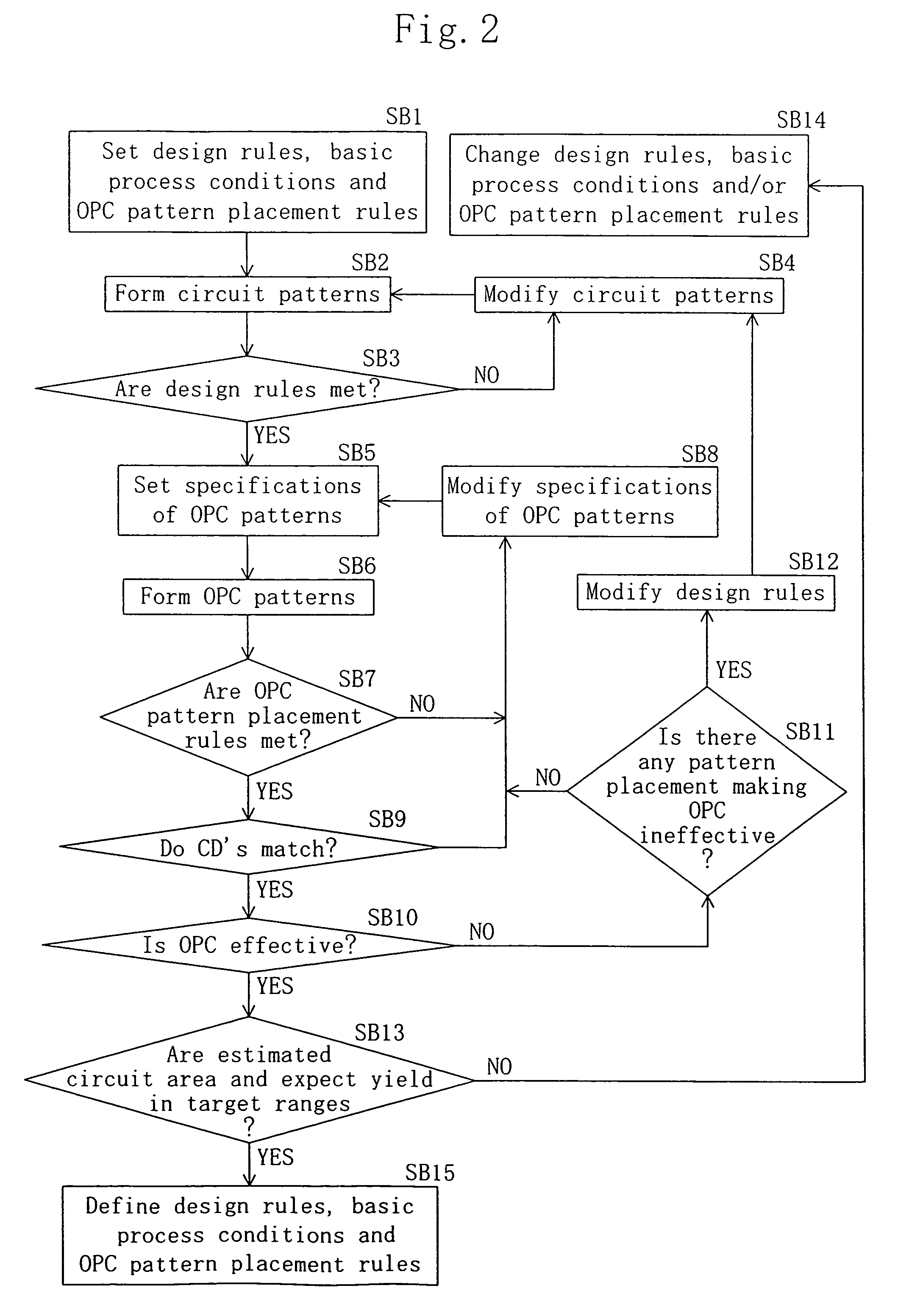Method for planning layout for LSI pattern, method for forming LSI pattern and method for generating mask data for LSI
a technology of lsi pattern and lsi pattern, which is applied in the direction of photomechanical treatment originals, instruments, and total factory control, etc., can solve the problem of increasing the difficulty of design rule concerning the extension size, the actual transfer pattern size is likely to deviate from the original design one, and the shrinkage rate becomes more and more difficult to achiev
- Summary
- Abstract
- Description
- Claims
- Application Information
AI Technical Summary
Benefits of technology
Problems solved by technology
Method used
Image
Examples
embodiment 1
[0081]Hereinafter, a first embodiment of the present invention will be described with reference to the accompanying drawings.
[0082]According to the first embodiment, a design rule is determined so as to satisfy the conditions that should be met to form OPC patterns of the type making optical proximity corrections effective when an LSI is fabricated. And circuit patterns are designed and mask pattern data is generated in accordance with the design rule determined.
[0083]Also, the OPC patterns are made from the circuit patterns in accordance with the design rule that makes the OPC effective, and basic process conditions are optimized based on the OPC patterns obtained. In this specification, the OPC can be regarded as “effective” when a pattern, which has been actually transferred onto a region with substantially the same area as an originally designed circuit pattern using this OPC pattern, ensures proper operation for a resulting circuit.
[0084]FIG. 1 illustrates a processing flow of ...
embodiment 2
[0122]Hereinafter, a second embodiment of the present invention will be described with reference to the accompanying drawings. According to the second embodiment, design rules are determined so as to satisfy the conditions that should be met to form required OPC patterns as in the first embodiment.
[0123]And circuit patterns are designed and mask pattern data is generated in accordance with the design rules determined. In particular, according to the second embodiment, each cell (basic circuit) being designed can be individually checked for the effectiveness of the OPC. Thus, a cell area can be reduced on a cell-by-cell basis.
[0124]FIGS. 10 and 11 illustrate a processing flow of an LSI mask data generating method according to the second embodiment.
[0125]First, in Step SC1 shown in FIG. 10, design rules, basic process conditions and OPC pattern placement rules are determined. In this case, the design rules and the basic process conditions are determined as in Step SA1 shown in FIG. 1....
modified example of embodiment 2
[0143]Hereinafter, a modified example of the second embodiment will be described with reference to the accompanying drawings.
[0144]FIGS. 13 and 14 illustrate a processing flow of an LSI mask data generating method according to a modified example of the second embodiment. In the second embodiment, cell-level OPC patterns are directly registered at the cell library in Step SC11. In contrast, according to this modified example, the step of making a cell-level OPC pattern includes the sub-steps of: setting the specification of the cell-level OPC pattern to be made; and making the cell-level OPC pattern to the specifications by a rules-based technique. In this manner, a circuit pattern and the specification of a cell-level OPC pattern associated with the circuit pattern can be registered at the cell library, instead of directly registering the cell-level OPC pattern.
[0145]The process steps SD1 through SD10 according to this modified example shown in FIG. 13 are different from the process...
PUM
 Login to View More
Login to View More Abstract
Description
Claims
Application Information
 Login to View More
Login to View More - R&D
- Intellectual Property
- Life Sciences
- Materials
- Tech Scout
- Unparalleled Data Quality
- Higher Quality Content
- 60% Fewer Hallucinations
Browse by: Latest US Patents, China's latest patents, Technical Efficacy Thesaurus, Application Domain, Technology Topic, Popular Technical Reports.
© 2025 PatSnap. All rights reserved.Legal|Privacy policy|Modern Slavery Act Transparency Statement|Sitemap|About US| Contact US: help@patsnap.com



